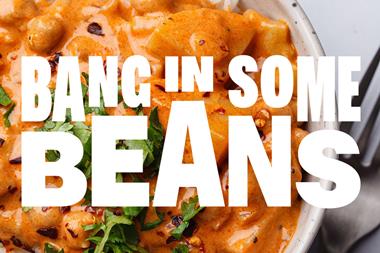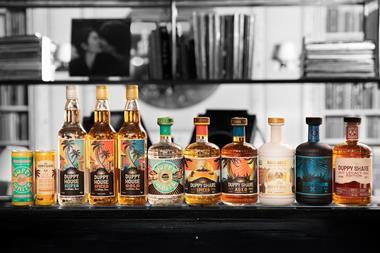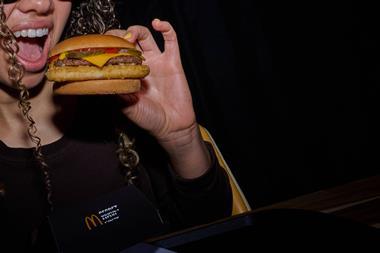Analysis by Sheila Eggleston
Jamie Oliver going on about spicy rubs would by itself be enough to ignite a passion for ethnic food had none existed before.
Spicy food is not just hot in the hands of a Naked Chef or an Ainsley Harriott. It is also deeply cool, it's hip, it's sophisticated, it's mass market, and of growing appeal to affluent career-driven young people with not much but enough time to experiment.
Britain's well documented love affair with the curry has now moved on to an array of further relationships with far more sophisticated fare. Manufacturers and importers are responding slickly. Cans of curry sauce still abound, but there's now a fast growing number of products offering convenience, complexity, and a drive for authenticity that is clearly backed by integrity and not mere marketing hype.
Growth is guaranteed. Of course, Brits have been won over by nice meals on long haul holidays around six million trips from this country this year, predicts Mintel not to mention the growing variety and quality of domestic restaurants. But there is far more to the success story of ethnic food than mere conversion of middle class whites.
This country is now a multicultural society and the practices and traditions of people of Asian, Jamaican, Afro-Caribbean origin are having a greater influence on society than is suggested by some generalistic market reports. Many parts of Britain are, now ethnic'.
"The UK's younger generation are as comfortable with ethnic food as they are with roast beef and Yorkshire pud," says Nick Peters, brand manager at importer and distributor Petty, Wood.
And he sees flourishing interest in hitherto little known cuisines. Peters' money is on Malaysian, Vietnamese and South African flavours making their mark in years to come.
And although in the minority now, Japanese, Korean and particularly Caribbean foods are attracting new users. Caribbean supplier Grace Kennedy estimates the value of the overall Caribbean market to already be in the region of £50-60m a year, its own sales growing 20%-30% year on year. Its latest efforts are a 12 strong range of Caribbean herbs and spices, the relaunch of Grace Jerk barbeque sauce and a ginger beer made from Jamaican root ginger.
Tradition and authenticity are Sco-Fro Foods' mantras. It sources all its products from UK multiple approved factories in the Far East.
Sales and marketing director Sonja Stewart says: "Consumers want dishes that taste just like those they have on holiday and are willing to pay a premium.
"Our new range of Indonesian and Singapore sauces satisfy the adventurous consumer wanting a quick and interesting meal solution."
All its products from sauces and instant noodles to spices are supported with recipe ideas.
But ethnic food that's not only authentic, but quick and easy to prepare is at the top of most people's wish list.
Van den Bergh's Chicken Tonight Sizzle & Stir takes a 10.6% and 15.5% value share in the oriental and Indian wet sauce markets respectively [Source: AC Nielsen 52 weeks to March 25 2000] while its Stir it Up! cooking pastes are appealing to younger women who are pressed for time.
Sharwood's head of marketing Jonathan Gatward says: "Innovation is vital in increasing frequency of purchase as consumers seek new food experiences."
Sharwood's is now planning to develop "new Asian cuisine" following the launch of its Taste of Asia range of Indonesian satay, Malaysian rendang, Singapore Laksa and Thai red curry jarred cooking sauces.
Using themed events to promote brands is becoming more popular with manufacturers and retailers.
Sharwood's backs Chinese New Year and Indian Diwali. Gatward says: "Events drive penetration and increase the average weight of purchase by existing consumers.
"Chinese New Year in February brought 11% more users into the ethnic market and Sharwood's as a brand grew from 28% to 33% during those weeks."
James LeBouedec, brand manager for Blue Dragon at G Costa, also believes events are great for boosting consumption. This year Blue Dragon is again supporting the Thai Food festival at Battersea Park in July.
Patak's believes strong branded promotions are more important than price. Director of UK marketing and sales Alison Cannon says: "Pricing isn't as crucial. People buy ethnic sauces to transform food. Knocking off 10p-20p won't help if a product doesn't perform on flavour."
Cheaper alternatives to eating out are proving a winner, with instant meal solutions finding a niche. Blue Dragon's Made Easy Kits in Chinese, Thai and Japanese only need meat, poultry or fish to make a meal, can now be ordered on the internet for home delivery to consumers.
Instore takeaways are encroaching more and more on the restaurant trade with all the multiples enlarging their serveover choices and increasing their bagged meal solutions in the chiller.
Somerfield's Curry to Go, a menu of six dishes including balti, Madras and accompaniments such as pilau rice and naan bread, is still being trialled at selected stores.
Influenced by travel and a rise in sushi bars, Japanese is becoming hip and trendy but still relatively untapped. Le Bouedec believes the market here is way behind the rest of Europe in sales and in popularity, but is "full of potential".
Companies such as Kikkoman are keen to exploit the craze for Japanese sushi, teriyaki and tempura. By adding a sukiyaki sauce to its soy sauce and teriyaki line up, it hopes to encourage more use in the home.
G Costa's latest venture is Korean food from noodle and snack specialist Nong Shim. Described as "wacky with youth appeal", these include three-minutes-to-heat hot and spicy packet noodles and cup noodles, and ready to eat snacks.
Ethnic food has adapted well to eating on the hoof with consumer friendly packaging, and more handheld snacks and microwaveable products.
Daloon Foods, which produces mini ethnic snacks like spring rolls and samosas, has seen a demand for larger portions and has introduced a 150g jumbo tandoori spiced vegetable samosa.
Research by Patak's shows that snacking up to five times a day instead of eating three "proper" sit down meals is the norm among young people. It claims its frozen wraps based on Indian frankies, snacks traditionally eaten on the streets in India, are successful because they microwave in three minutes. By the end of the year, the brand, now 14 months old, is forecast to be worth £3m by Patak's.
The company's latest snack, Curry Break, is an ambient ready meal which can be microwaved in two minutes and eaten straight from the pot. Rsp is only 99p.
Both Sharwood's and Patak's say category growth will be driven by packaging.
Patak's sees its vibrant contemporary look on its new stir fry sauces as a way to woo the young and affluent.
And easy to use foil pouches have been used for Patak's Create a Curry bases. Cannon says: "These pastes help to take the fear out of cooking. You just use it and bin it."
Bart Spices' new chicken based ready meals come in pouches. And pouches will also play an important part for distributor General Food Trading.
"With pouches you can concentrate on two serving packs which encourage repeat purchases," says sales and marketing manager David Backshall. "They are light, they have a better price point and can be used and thrown away."
GFT is launching a five strong range of Indian ready meals under the Ashoka name which are made in Bombay. Initially they will be in 450g ringpull cans but the aim is to switch to pouches.
It is also launching Thai Delight, authentic Thai recipes developed by US restaurateur Dr Foo Swasdee. Waitrose will be taking five lines.
RHM Frozen Foods' Sharwood's range of Indian, Chinese and balti frozen meals has benefited from its heat n' eat straight from the bowl presentation.
Research by Birds Eye Wall's shows portion size and quality of ingredients will become increasingly important. It already uses chicken breast in its frozen ready meals. Naan bread and other accompaniments will also offer a "takeaway feel".
RVP Foods has focused on portion size with its latest "takeaway in your freezer".
It has launched Indian Express in a whopping 740g size which includes pilau rice and a higher than average meat content.
{{FOCUS SPECIALS }}
Close menu
- Home
- Retail & Wholesale
-
Products & Suppliers
- Back to parent navigation item
- Products & Suppliers
-
Product Categories:
- Back to parent navigation item
- Product Categories:
- Alcoholic drinks
- Bakery
- Cereals & breakfast
- Cheese
- Chicken & poultry
- Chocolate
- Confectionery
- Crisps, nuts & snacks
- Dairy
- Fish
- Fresh produce
- Frozen
- Household
- Meat
- Own Label
- Sauces & condiments
- Seasonal
- Soft drinks
- Vaping
- Vegan & plant-based
- World foods
- Suppliers
- People
- Reports & Data
-
Topics A-Z
- Back to parent navigation item
- Topics A-Z
-
Popular topics:
- Back to parent navigation item
- Popular topics:
- Cost of living crisis
- Crime
- Deposit Return Schemes
- Finance
- Government & Regulation
- Health
- Inflation
- Loyalty
- Marketing
- Mergers & Acquisitions
- New Product Development
- Sourcing
- Supply chain
- Sustainability & environment
- Technology
- Ultra Processed Foods
- Vaping
- A-Z all topics
- Content by type:
- Events
- Ask iA (beta)
- Subscribe now
Sign in to comment on this article
Not logged in before? Register for FREE guest access today.
You will be able to:
- Read more stories
- Receive daily newsletters
- Comment on stories
Advert



















No comments yet